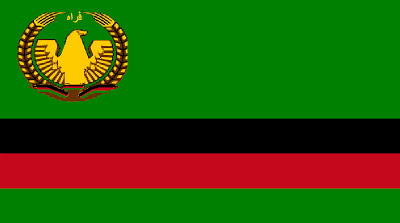Afghanistan has had more changes of its national flag during the 20th century than any other country in the world. It has had a massive 20 different flags since the first flag.
The current flag has been in use since 2001 and is similar to the one used between 1930 and 1973. The Black, red and green colours have featured on most flags. The official flag has the Afghanistan emblem in the centre:

Unlike most states which use a federal type system of government Afghanistan does not have sub national flags for individual provinces. I have designed some flags for a handful of the 34 provinces.
First up is the flag for the Province of Badakhshan:
It features the national colours at the hoist, and a simple mosque flanked by two flags as appears in the national emblem, in the centre. The text above and below reads Badakhshan in Persian at the top, and Pashto at the bottom. The colour green is most prominent as it represents prosperity and hope for the future and is often associated with the Islam Religion which is very important in Afghan society.
Next is the Province of Bamyan:
This flag is a horizontal tricolour in the national colours. This is one province for which I designed a seal, or emblem. It consists of a corn wreath (similar to national emblem,) banners like the provincial flag (horizontal tricolour.) The centre of the emblem has an open Koran the Muslim holy book. This symbolises the central role the religion plays in society. The top has Bamyan written in Persian.
Next is the Province of Daykundi in the central part of the country:
Like that of Bamyan this flag is a horizontal tricolour. the emblem in the centre features the mosque flanked with flags, placed in an eight pointed star, and a laurel wreath. Of course the mosque and flags are from the national emblem.The eight pointed star represents the eight districts in the province, and the laurel wreath represents pace.
Next is the flag of Helmand Province:
This flag is white with a diagonal black, red and green stripe dividing the flag into two fields. The bottom field towards the hoist has the mosque and flags from the national emblem. The second field has thirteen stars in a circle which represents unity and the thirteen districts of Helmand. The colour white represents pace.
Next is Herat:
Like that of Badakhshan this flag features the national colours and a lot of green with the same symbolism.
The province emblem is based on and similar to the national emblem used between 1928-1929 by King Amanullah. It features the wheat wreath, and the sun rising over the mountains of Afghanistan symbolising the dawn of a new age.
Next is Jowzjan Province:
Again we see the use of the national colours in a horizontal tricolour. The province seal features a wheat wreath and banners. The Koran is at the centre of the wreath, and Jowzjan in Persian is at the centre.
Next is Khost:
This is one of two ensign type designs, with the national flag (without emblem) in the canton. As there are so many provinces I thought perhaps a standard design might work. The white field symbolises peace and the name Khost is in Pashto.
The other ensign type design was Kunduz:
This is a black field, there are three reasons for this:
- it is one of the national colours
- I think it works well
- It is a colour that often features on Islamic flags and is the colour used for the president's flag
Next is Laghman Province
I have used this design with the five stars fairly frequently. The stars represnt the provinces five districts and the text reads Laghman in Arabic.
Nimruz Province is next:
It features the national colurs at the hoist. Green is used a lot as mentioned before. The badge features the National emblem in a black pentagon. The Pentagon symbolises the five districts.
Panjshir Province is next:
The common design as stated before. This flag features the mosque design from the national emblem. The five stars represent five districts.
Samangan Province is next:
This design is used once more. It has the full national emblem in the fly. The five stars again represent this provinces five districts.
Next is Ghōr:
A horizontal tricolour with a larger red bar. The ten stars represents the provinces ten districts.
Next is Baghlan Provence:
This flag has two green and red fields, separated by a diagonal bar in the national colours. The green field has a simple mosque and wreath emblem, representing the nation. The red field has a province emblem. The province emblem features 16 stars representing 16 districts around a sun representing a new age.
Last but not least is Farah Province:
This flag features the national colours, and the province seal on a green field in the hoist. The seal consists of a wheat wreath, with a banner in the national colours at the base. The centre has an eagal which often features in Arab state symbols. Farah in Arabic is at the top of the seal.
All designs are mine except the national flag. These flags do not represent mine or any other political opinion or my religious viewpoint. All comments welcome.















0 comments:
Post a Comment